1 Buying your Buddhist thangka conscientiously
Our catalogue of Buddhist thangkas
Our Buddhist thangkas come from artisans who respect the Buddhist canons.
Each thangka has been individually checked to ensure their conformity and correctness for various Buddhist practices such as visualization exercises.
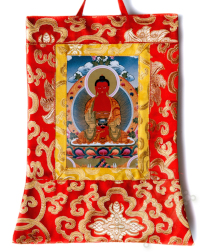 |
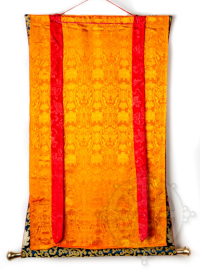 |
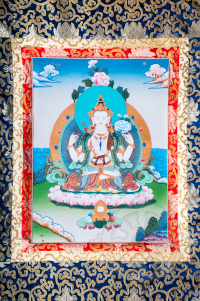 |
BUY YOUR TIBETAN BUDDHIST THANGKAS HERE.
Table of content
- Motivation - Why buy?
- Practice - Which deity to choose?
- The store - Where to buy?
- Quality - What to buy?
- Consecration - Blessing of the thangka by a master
- The material - What is the thangka made of?
- Budget - How much to spend?
- Location - Where to place your Buddhist thangka?
- The end of your relationship - What to do?
- Conclusions
1.2 Motivation - Why buy?
Your motivation is the best guide to help you find the Buddhist thangka that suits you best.
The reasons behind the choice of a Buddhist thangka are many and are related to our state of mind and emotions. The most common reason to have your own Buddhist statue is to use it as:
- An instrument of devotion: A Buddhist thangka can help you to better identify and remember the qualities of divinity and integrate them into your practice using the teachings of Buddhism.
- A support for meditation practices: Through the thangka and deity visualization, you can practice various exercises to find inner peace.
- A blessing to your personal or professional environment: Buddhist thangkas can be consecrated and blessed by your lama / teacher / spiritual friend. Your daily routine while passing the thangka, will be to remind you of the qualities of the deity and / or make offerings to him (incense, flowers, saffron water, etc.).
- An appreciation of the work of art: you recognize the artistic quality of this work and thus contribute to perpetuating this craft tradition. You can of course use it to create a specific atmosphere in your living space.
Try to really internalize this question: what is your *REAL* motivation behind the act of buying a Buddhist thangka? The answer will guide you in your search for a Buddha thangka that suits you.
1.3 Practice - Which deity to choose?
If you have been practicing for a few years, you have probably already met a spiritual friend who is helping you along the way. Depending on your personality, on your daily practice, this spiritual friend can advise you on the divinity that possesses the qualities to be developed in yourself.
Here is a sample of the main deities of Buddhism:
- Shakyamuni Buddha: Commonly referred to as "the Buddha". He is a historical figure who lived in the 6th century BC. He was born in historical India under the Sakya clan and was called Siddhartha. He is the symbol of enlightenment.
- Avalokiteshvara / Tchenrezig: Incarnation of the compassion of all Buddhas.
- Vairochana: is one of the primordial Buddhas. Vairochana represents the purity of enlightenment.
- Arya Tara / Green Tara: Named the Great Liberator, she embodies the protection of all beings.
Each deity has its own set of qualities.
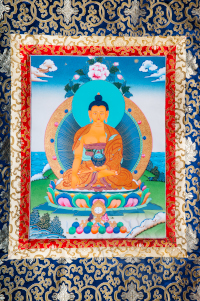 |
 |
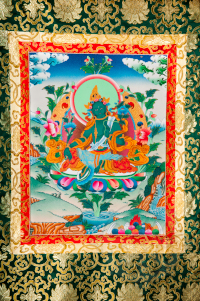 |
1.4 The store - Where to buy?
Before you decide to buy, you should identify a store that guarantees the quality of its craftsmanship. Here is some mandatory information you need to get from a professional seller:
- Origin: The origin of the product provides an indication of the quality of the thangka maker. For example, for the canons of Tibetan Buddhism, the best craftsmen come from Nepal. From Nepal, the art of making Buddhist thangkas has been exported to Tibet, where it has become increasingly popular.
- Warranty: Are the duration and conditions of the warranty clearly stated?
- Description: Is the description sufficiently detailed (dimensions, weight, high-resolution image, material, manufacturing process, etc.)? By having the possibility to check these details, you have the possibility to detect inconsistencies (e.g. size vs. weight for a given type of material, etc.).
- Illustrations: Are the images of the Buddhist thangka sufficiently numerous and detailed for you to be able to check compliance with the Buddhist canons?
- Ethical values: does the shop respect certain ethical rules (fair price to the craftsman, ecological packaging and transport, carbon compensation for transport, etc.)?
- Precautions for use: does the site provide instructions for the care of a thangka? How to clean it? How to store the thangka? How to respect the Buddhist label? Etc.
The quality of the information provided by the store is a good indicator of the seriousness and professionalism of the store.
1.5 Quality - What to buy?
As an instrument of practice, a Buddhist thangka must arouse in the practitioner a sense of devotion or refuge towards the divinity represented. To this end, the quality of the thangka must be high.
In order to evaluate the quality of a Buddhist thangka, it is important to verify aspects such as facial expression, accuracy of gestures and postures, etc.
TOP
1.5.1 The face
The face is the most important factor to look for when buying a Buddhist thangka.
For example, if you decide to buy a hand-painted thangka, you should check that the gold paintings are made from a 24k gold amalgam. For some deities, the facial expression should represent compassion, considering that it should invoke in us devotion and respect.
The finer and more precise the painting of the thangka, the better the quality of the thangka.
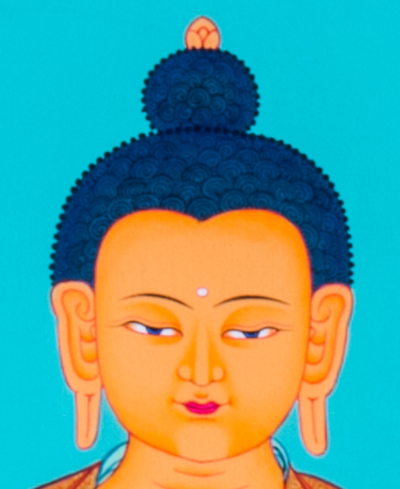 |
1.5.2 The body, gestures and postures
The deities are represented in different postures symbolizing the multiple qualities and aspects of the divinity. Here are a few examples:
- Green Tara has her right foot on a small lotus that symbolizes her readiness to help those in need.
- Shakyamuni Buddha's hand gesture touching the earth symbolizes his willingness to use the earth as a testimony of his enlightenment.
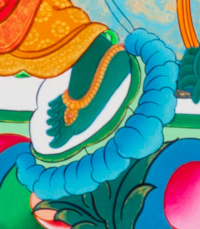 |
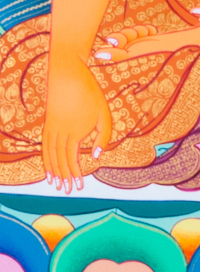 |
Buddhas and deities are represented making gestures (mudras) with their hands and their legs are in certain postures.
When you buy a Buddhist thangka, you must check the exact respect of the canons of your Buddhist tradition.
1.5.3 Attributes
The deities possess various attributes symbolising their multiple qualities. For example, for example..:
- Clothing: The deities sometimes wear the traditional monk's robe or more elaborate clothing, such as a shawl, a silk skirt, a tunic decorated with gold patterns, etc. Clothes often represent total liberation from the torments caused by internal disturbances;
- Jewellery: ear, necklace, wrist, belt, etc. represent the fact that sensory pleasures are not suppressed but transformed into ornaments of wisdom.
Be careful, the attributes may vary from one text to another, from one practice to another.
1.6 Consecration - Blessing of the thangka by a master
It is not necessary to consecrate a Buddhist thangka, but if you do, ask a recognized meditation master or ideally your Root Lama to sign and bless your thangka.
For example, in the context of Tibetan Buddhism, a thangka is signed on the back using a classical text. The signature of the thangka is placed in a specific place in relation to the chakras of the deity represented on the front. After the signature, the Buddhist thangka is blessed by the Lama. The consecrated thangka then becomes the incarnation of the qualities of the deity and blesses the practice of its holder.
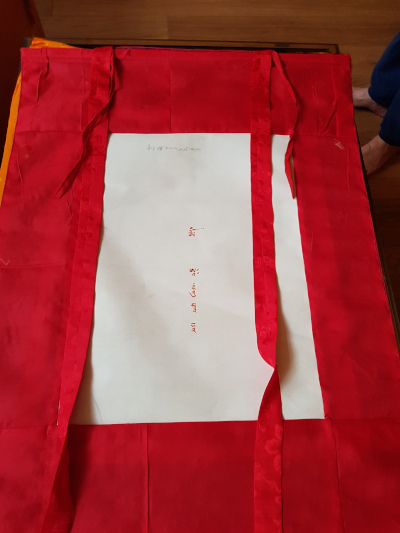 |
1.7 Budget - How much to spend?
It is not necessary to spend a fortune on a Buddha thangka for your daily practices.
Reproductions of Buddhist thangkas corresponding to the Buddhist canons start from a budget of about 15 € for a thangka of +-15 cm.
Of course, there is no upper limit! You will find very elaborate thangkas made by the greatest masters at several tens of thousands of euro for a temple.
Our advice is as follows: start spending a small budget for your first Buddhist thangka, then, as you practice and develop an affinity with the deity, you can invest a larger budget in a beautifully crafted thangka.
TOP
1.8 Location - Where to place your Buddhist thangka?
1.8.1 Behind your altar
Buddhist thangkas are not decorative objects. The acquisition of a thangka implies that one wishes 1) to use it for one's personal practice and 2) to devote a privileged space to it. It is not desirable to use a thangka as a decorative object or for any purpose other than practice.
1.8.2 Somewhere in your house/appartment
It is advisable that your Buddhist thangka be placed in an elevated, clean place and be separated from more "worldly" products. Other objects should not be placed above the Dharma thangkas.
Feng Shui is another valid method to know where to place your Buddhist thangka.
1.9 The end of your relationship - What to do?
If you don't want to keep your Buddha thangka, don't throw it away!
Contact the nearest Buddhist center and make a donation. By doing so, the thangka will bring you merit until the end of your relationship.
1.10 Conclusions
A Buddhist thangka can bring many benefits, but you must first find the one that suits you!
Remember: on the Internet, you can find many types of Buddhist thangkas (deities, quality, price, etc.).
If possible, don't hesitate to also ask the seller to have the Buddhist thangka blessed by a monk from the nearest Buddhist centre.
2. Tibetan Thangka (or thanka, tanka)
2.1 Definition of thangka
Extract from wikipedia.
A thangka, also spelled "tangka", "thanka" or "tanka", literally "thing that is unrolled", "scroll", is a painting, drawing, or fabric on canvas originating from India and characteristic of Tibetan Buddhist culture.
They come in all sizes, from portable thangkas that can be rolled up and unrolled using two sticks passed through hems, to monumental thangkas intended to be unrolled along a slope or a wall and which can reach several tens of meters.
The subjects of the thangkas are related to Buddhism and can represent :
- symbolic mystical diagrams (mandala);
- a wheel of karmic existence (bhavacakra);
- deities from Tibetan Buddhism or the Bön religion, sometimes related to elements of history;
- portraits of tulkus or lamas of high rank in the monastic hierarchy; they are sometimes accompanied by their benefactors or protectors.
Thangkhas are most often intended to serve as a support for meditation.
The subject is depicted in the centre, surrounded by subordinate figures forming part of his retinue, his various divine forms, etc. The subject is represented in the centre, surrounded by subordinate figures forming part of his retinue, his various divine forms, etc. The important deities of the pantheon are represented in the upper part. The lower part is reserved for the various offerings and the guardian deities of the Law.
Mountains are also depicted, an element of traditional Tibetan iconography.
2.2 More information on thangkas
The fabric frame of a Thangka also has an important spiritual significance inseparable from the image itself. The latter and the frame complement each other to form a symbolic but also artistic unity as there are no real boundaries between the two. The frame with its clearly delineated fabric parts reflects the basic structure of the Tibetan world view and at the same time evokes the spiritual themes that are found in the image in the form of objects.
One of the most representative painting styles of the thangkas, Karma Gadri, was created by the 8th Karmapa, head of the Karma Kagyu school of Tibetan Buddhism, who was also a fully realized artist. The characteristics of this style are: spacious, transparent and meditative.
Thangka's painting developed in the northern Himalayan regions. Newari Thankas (also known as Paubha) were developed in the Kathmandu valley from the 13th century onwards. It is therefore a very ancient craft.
2.3 Categories of thangkas
Hand-painted Buddhist Thangka
Around the 10th century, there were important religious exchanges between India and Tibet. With these great sages from India, many artists arrived in Tibet with the aim of "illustrating" messages, objects, symbols or religious practices. This is still the goal of modern thangkas today: to illustrate and tell.
The painter always determines the composition.
He thinks about the main characters, the type of (imaginary) landscape where they should be situated and where he should place some more architectural elements and other details.
Most painters are laymen. They have a sufficiently extensive knowledge of iconography and rely on descriptions in ritual books. In exceptional cases, monks or other religious specialists may also be consulted.
The composition is generally symmetrical, presenting the main character at the centre of an imaginary vertical axis. Smaller characters and deities are grouped on either side. The hierarchy of characters is, however, a principle of the utmost importance. In thangkas composed of various types of characters, spiritual guides and other gurus will occupy the central position. The highest priest or the supreme deity of a religious system or school will appear at the top of the composition. This will be followed in descending order by the yidams, buddhas, bodhisattvas, dakinis, dharmapalas, lokapalas and minor gods. The composition is adapted to the number of characters desired.
Modern thangkas are indeed becoming more flexible both in the positioning of the characters and in the details. The Tibetan pantheon also recognizes a hierarchy of sizes. Depending on the degree of importance, a character will be painted more or less large. The number of size categories can thus vary, depending on the dom school, from four to eleven dimensions. The artists know the sizes of the main gods and figures as well as their respective characteristics. And for the less known, they can refer to books and paintings. Standard proportions are determined
for the different parts of the body, such as hands, feet or hips, but also for the distances between these parts (e.g. between the nose and chin).
Reproduction of a Buddhist thangka
Instead of a real handmade painting, it is possible, thanks to modern digitalization techniques, to obtain a reproduction of thangkas at a lower cost.
It will either be printed on high quality photo paper and/or mounted on a cloth support for Buddhist practice use.
2.4 Deities frequently represented on Buddhist thangkas
Here is a non-exhaustive list of these Tibetan thangkas:
- Amitabha Buddhist Thangka: Amitabha Buddha is often represented as the Emanation Body. He makes the mudra of meditation, the Dhyana Mudra, and holds a bowl of alms filled with the nectar of wisdom in his hands, symbolizing his kindness in giving vast and profound instructions to beings. The alms bowl represents wisdom and non-attachment. It refers to the fact that the monks go every morning to beg for their food from the laity in exchange for prayers, the bowl is also one of the few traditional objects they possess along with the monastic vestments.
It is covered with the three pieces of religious clothing: a shirt and trousers as underwear, and a cloth (Zen) as clothing which correspond respectively to the 3 trainings: discipline (skt. Vinaya), meditative concentration (skt. Shamata) and transcendental knowledge (skt. Vipassana.). It bears the major marks and minor signs of a fully awakened manifestation of Nirmanakaya. The perfection of the Buddha's state is expressed in the characteristics of his body, to which 32 major marks and 80 minor signs are traditionally attributed. - Buddhist Thangka of Amitayus Buddha: Amithayus (Amithaba in his adorned form) reigns in the "Pure Western Land of Bliss", a wonderful world, pure, perfect, devoid of evil and suffering. Amithayus is represented as Shakyamuni Buddha, but with the gestures (mudrā) of meditation or transmission of the law.
- Shakyamuni Buddha's Buddhist Thangka: The Buddha is often depicted in a seated position, with his right hand resting on his right leg and fingers pointing towards the ground. This is the "Mudra Bhumisparsha" which means "touching the ground" or "taking the earth as a witness". The left hand rests on the knee with the palm facing upwards. This Buddhist statue represents an important event in the Buddha's life when he attained enlightenment below the Bodhi Tree. After the Buddha overcame the many trials of the demon Mara and attained Enlightenment, the demon challenged him for lack of a witness. The Buddha then extended his right hand towards the earth. The earth began to tremble, testifying to the Buddha's Ultimate Realization, and the demon king disappeared.
The perfection of the Buddha's state is expressed in the characteristics of his body, to which 32 major marks and 80 minor signs are traditionally attributed. - Thangka Buddhist Medicine Buddha, Sangye Menla:On his left hand is a bowl filled with medicinal substances. According to some texts, the bowl, carved from a block of beryl, has twelve sides recalling the twelve great wishes made by Sangye Menla for the good of all beings. He is regarded as the Medicine Buddha because his compassion extends to all suffering of beings. In his right hand, the Buddha holds a stem of arura (Terminalia chebula, of the genus myrobolans), a plant considered to be the queen of medicinal plants. Indeed, each of its parts is attributed powerful and specific healing virtues.
- Thangka Buddhist of the Boddisatva Chenrezig, Avalokiteshvara:Chenrezig, "he who looks with clear eyes" is the Tibetan incarnation of Avalokitésvara, the Bodhisattva of compassion and is considered the protector of Tibet. Chenrezig, or four-armed Avalokitesvara, is the most popular form of the deity and its symbolism, as described by Bokar Rinpoche, is as follows:
- the white color of his body: he is totally pure, free of all veils;
- a single face: the essence of all phenomena is of one flavor;
- the 4 arms: the 4 unlimited feelings (love, compassion, joy, equanimity);
- the two legs crossed in the vajra posture: he does not remain in the extremes of nirvana for oneself and samsara; he unites compassion and emptiness;
- the jewel held in joined hands: it fulfills the good of all beings;
- the rosary in the right hand: it pulls all beings towards liberation;
- the lotus in the left hand: it possesses the knowledge on which compassion for all beings is based; moreover, just as a lotus grows from the mud without its flower being soiled in any way, Avalokita works in the world without being tainted by its imperfections;
- the doe's skin on his shoulder: the legendary kindness of the doe symbolizes the thought turned towards the good of beings;
- the various jewels: the richness of the qualities of his awakened mind;
- the silks of five colours: the five wisdoms.
- Buddhist Thangka of the Boddisatva Green Tara: Green Tara is one of the 21 forms of Tara. Its green colour indicates that Tara acts quickly for the good of those who pray to her. The Buddhist thangkas represent it according to the following symbolism:
- The left leg, bent, indicates that it is no longer subject to internal disturbances;
- the right leg, already half unfolded, indicates that she is ready to get up to help beings; thus Tara, while being totally free from the imperfections of samsara, remains there to help all those who suffer: she relieves them of their temporal difficulties and, on the spiritual level, guides them towards liberation, the end of all suffering;
- with her right hand, she grinds the gift, signifying that she bestows both the ordinary and the sublime accomplishments;
- the left hand performs the mudra of the refuge: her thumb and ring finger touch to symbolize the union of skillful means and knowledge; her other three fingers are erect and represent the Three Jewels: Buddha, Dharma and Sangha;
- the lotuses whose stems she holds in her hands indicate that all the qualities of realization have been fully realized in her.
- Buddhist Thangka of Guru Rinpoche, Padmasambava: Guru Rinpoche also called Padmasambhava is often represented in Buddhist thangkas as follows:
- The symbolism of his body as represented in a true thangka is explained as follows: one face: absolute truth is one; eyes wide open: he always remains in absolute nature; two legs: identity of samsara and nirvana; sitting in the posture of "royal ease": the whole manifestation obeys him.
- His headdress has the following meaning: its general shape is that of a five-petalled lotus, meaning that Padmasambhava belongs to the lotus family; the three vulture feathers planted at the top symbolize the dzokchen, the summit of teaching and realization in the Nyingmapa tradition; one can also distinguish on the front of the headdress a sun and a moon, symbols of the two bodhichitta, ultimate and relative.
- He wears three types of clothing: the monastic garments represent the small vehicle, his blue garment the large vehicle, his brocade cape the diamond vehicle.
- In his right hand, he holds a vajra (symbol of the transformation of poisons into wisdom) while at the same time he makes the moudra of the threat, showing that he is subduing the negative forces.
- With his left hand, in the mudra of meditation, Padmasambhava carries a skull cup containing a long-life vase filled with the nectar of immortality, testifying to his attainment of the state beyond death.
- The khatvanga, a sort of trident that he holds on his left side, symbolizes his parhedron, Mandarava.
- Buddhist Thangka of Boddisatva Maitreya: Maitreya (Sanskrit word meaning "friendly", "benevolent"). He is the next Buddha to come when the Dharma, the teaching of Shakyamuni Buddha, is gone.
2.5 The consecration
Consecration is a Buddhist blessing ritual in which the painting is blessed and then the mantra OM HA HUNG is written by the Lama on the back of the painting, each syllable being written on the representations of body, speech and mind.
(*)The-Dharma-Store.com does not and will never sell ANY consecrated ritual objects.
The-Dharma-Store.com does not consecrate thangkas and our advice is to contact a Lama in your community to consecrate your painting according to the rituals of your school.
Nevertheless, if the consecration of the thangka is not possible for you, please be aware that we are nevertheless connected with several Buddhist centers and if it is your wish we can ask for the consecration of your painting before sending it to you. In this case, and before making the request for consecration to the Lama, we suggest that you make a "suggested" donation which will be entirely donated to the Dharma center concerned. The consecration of the thangka depends on the presence and availability of the Lama and may take 2 to 3 weeks. We will of course keep you informed throughout the consecration process.
3. Your Buddhist thangka from The-Dharma-Store.com
3.1 The warranty from The-Dharma-Store.com
The Buddhist practitioner uses a thangka as a representation of his yidam, or meditation deity, as a guide. He/she visualizes him/herself as this deity, or appears in front of it and in the presence of the figure thus internalizing the qualities of Buddha so that they become their own.
Here are some of the guarantees that we bring you with the thangkas that you will find on our website the-dharma-store.com :
- All our thangkas are mounted in a traditional brocade (the exact colors and textile pattern will vary from thangka to thangka) which is proportional to the size of the painting it mounts (about 1.8 times the size of the painting).
- All the "gildings" of our thangkas are made from a paint with gold pigments. All the gilded parts of these paintings are guaranteed for 10 years. Do not hesitate to return a thangka for which you would observe degradations of the gilded paint.
- All our thangkas are hand-painted by Nepalese craftsmen who have followed a classical training in Tibetan painting. Some of them belong to families who have been painting for several generations. Therefore, the learning process to paint thangkas is rigorous. During the first three years, students learn to draw Tibetan Buddhist deities using precise grids dictated by the Scriptures. The next two years are devoted to the techniques of grinding and applying the mineral colours and pure gold used in the paintings. In the sixth year, students study in detail the religious texts and scriptures used for the subject of their work. To become an accomplished thangka painter, a minimum of ten years' training is required under the constant supervision of a master. The training process is exclusively based on mastering each step: First, they just learn how to draw the shape, then how to colour the different areas drawn, and then, depending on their progress, they are promoted in various painting techniques such as shading, lining, drawing, gold and many others. Students still need five to ten years to acquire sufficient mastery to paint thangkas. Most importantly, Tibetan Thangka painting requires prolonged concentration, attention to detail and knowledge of Buddhist philosophy, and must be done in a peaceful environment.
- Our thangkas are delivered with a veil to cover them.
3.2 Maintenance of a thangka
Like any work of art, a thangka must be stored carefully. Here are a few common sense rules:
- Protect the thangka from moisture or extreme heat. Avoid hanging the artwork on a wall where the sun's rays shine directly on it or on a wall that is too damp.
- Place it in a room with stable room temperature.
- Revise the contacts and rubbing by insulating it as much as possible. If shocks are caused, cracks may not appear until much later.
Thangkas, like all religious representations, are instruments of our Liberation. It is therefore necessary to show some form of respect towards the thangkas. We remind you here of some ethical rules:
The image of Buddha or of a deity is not supposed to be used just anyhow and on any object: T-shirts, trousers, plates, slippers, etc.
The thangkas of the Buddha and other deities are objects of practice that have the power to protect against inferior rebirth and to show the path of Liberation. They should therefore be treated with respect, i.e. kept off the ground and away from places where people sit or walk.
Thangkas should be covered or protected when not in use.
For transport, the thangka should be rolled so that the image and veil face outwards. A cord is used to tie the thangka.
Thangkas should be placed in an elevated, clean place, separated from more "mundane" materials. Other objects should not be placed above the thangkas.
Thangkas are not decorative objects. Acquiring a painting implies that one wishes to use it for one's practice and devote a sacred or privileged place to it for one's practice.
If you no longer wish to keep your Buddhist thangka, do not throw it away! Please contact the nearest Buddhist center and make a donation. By doing so, you will benefit from its merits until the end of your relationship.
3.3 Order a custom-made thangka
If you don't find what you are looking for, contact us and we will advise you. Do not hesitate to contact us to provide you with an estimate both in terms of availability and cost for a specific order for a Dharma center or an individual.
